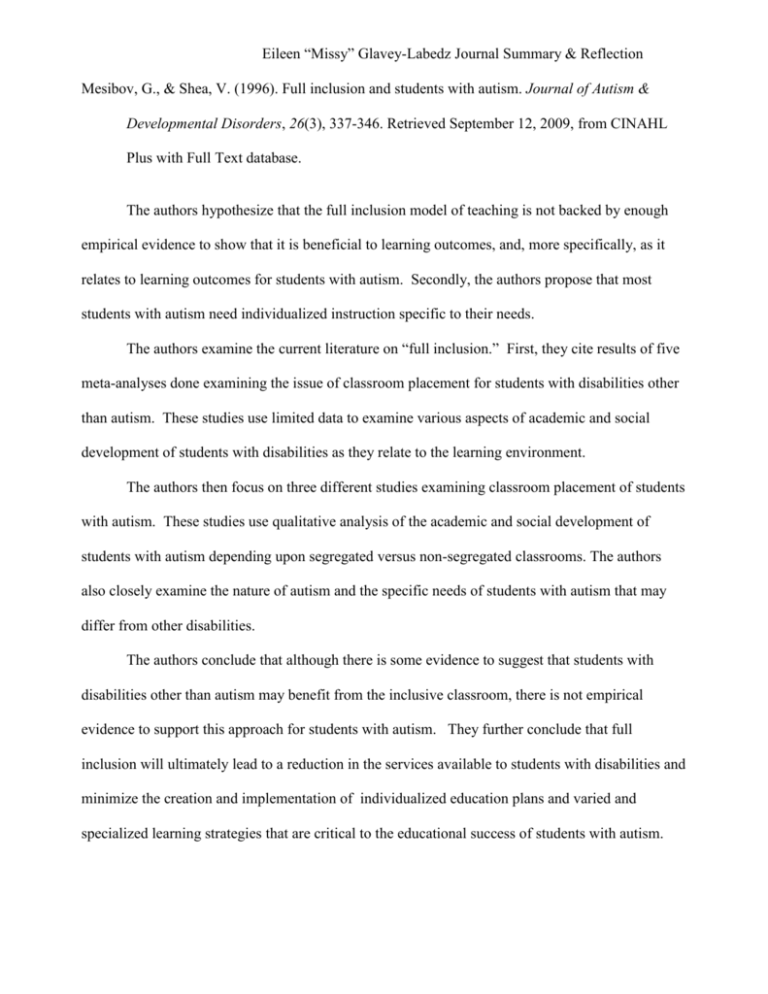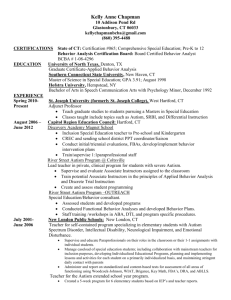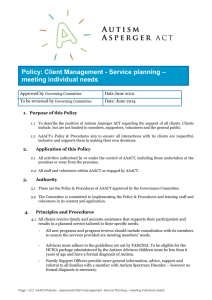JournalSummaryInclusionAutismRevised
advertisement

Eileen “Missy” Glavey-Labedz Journal Summary & Reflection Mesibov, G., & Shea, V. (1996). Full inclusion and students with autism. Journal of Autism & Developmental Disorders, 26(3), 337-346. Retrieved September 12, 2009, from CINAHL Plus with Full Text database. The authors hypothesize that the full inclusion model of teaching is not backed by enough empirical evidence to show that it is beneficial to learning outcomes, and, more specifically, as it relates to learning outcomes for students with autism. Secondly, the authors propose that most students with autism need individualized instruction specific to their needs. The authors examine the current literature on “full inclusion.” First, they cite results of five meta-analyses done examining the issue of classroom placement for students with disabilities other than autism. These studies use limited data to examine various aspects of academic and social development of students with disabilities as they relate to the learning environment. The authors then focus on three different studies examining classroom placement of students with autism. These studies use qualitative analysis of the academic and social development of students with autism depending upon segregated versus non-segregated classrooms. The authors also closely examine the nature of autism and the specific needs of students with autism that may differ from other disabilities. The authors conclude that although there is some evidence to suggest that students with disabilities other than autism may benefit from the inclusive classroom, there is not empirical evidence to support this approach for students with autism. They further conclude that full inclusion will ultimately lead to a reduction in the services available to students with disabilities and minimize the creation and implementation of individualized education plans and varied and specialized learning strategies that are critical to the educational success of students with autism. Eileen “Missy” Glavey-Labedz Journal Summary & Reflection In the article referenced above, the authors make a good argument against assuming that the best learning environment for all students, including students with disabilities, and, particularly, students with autism, is in a “full inclusion” classroom. It is important that in placing students who have autism, and for all students with disabilities in my opinion, to closely examine the nature of the disability and the individual needs of the child before determining their placement in a particular classroom setting. The fundamental concept of “full inclusion” “is that students with special needs can and should be educated in the same setting as their normally developing peers, with appropriate services, rather than being placed in special education classrooms or schools.” (Mesibov & Shea, 1996) At first consideration, this appears to be the fair and equitable thing to do, but is it really taking into account the individual needs of learners with disabilities? Is the policy of “full inclusion” based on a philosophy of “good will” or is it based on empirical evidence to support it being implemented? “As is too often the case in education, the philosophical movement for full inclusion has preceded systematic research on its assumptions or effectiveness.” (Mesibov & Shea) Additional research is needed on “full inclusion” before further implementation, particularly for students with autism. Most students with autism “need special instruction in individually designed settings that minimize their deficits and present information in ways they comprehend.” (Mesibov & Shea, 1996) Although in theory, the full inclusion setting would have appropriate services readily available for students with autism, it is not always a reality. If a student with autism is moved into a regular education classroom for full inclusion and they do not qualify, or the school cannot provide an aide, the regular education teacher is left with managing an entire class of neuro-typical students while also being responsible for giving individualized instruction to the student(s) with autism. This is in many cases an insurmountable challenge for the teacher to say nothing of the detrimental impact of learning on all students in the classroom.







